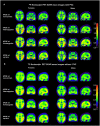Sex modifies APOE ε4 dose effect on brain tau deposition in cognitively impaired individuals
- PMID: 33876815
- PMCID: PMC8634082
- DOI: 10.1093/brain/awab160
Sex modifies APOE ε4 dose effect on brain tau deposition in cognitively impaired individuals
Abstract
Recent studies in cognitively unimpaired elderly individuals suggest that the APOE ε4 allele exerts a dosage-dependent effect on brain tau deposition. The aim of this study was to investigate sex differences in APOE ε4 gene dosage effects on brain tau deposition in cognitively impaired individuals using quantitative 18F-flortaucipir PET. Preprocessed 18F-flortaucipir tau PET images, T1-weighted structural MRI, demographic information, global cortical amyloid-β burden measured by 18F-florbetapir PET, CSF total tau and phosphorylated tau measurements were obtained from the Alzheimer's Disease Neuroimaging Initiative database. Two hundred and sixty-eight cognitively impaired individuals with 146 APOE ε4 non-carriers and 122 carriers (85 heterozygotes and 37 homozygotes) were included in the study. An iterative reblurred Van Cittert iteration partial volume correction method was applied to all downloaded PET images. Magnetic resonance images were used for PET spatial normalization. Twelve regional standardized uptake value ratios relative to the cerebellum were computed in standard space. APOE ε4 dosage × sex interaction effect on 18F-flortaucipir standardized uptake value ratios was assessed using generalized linear models and sex-stratified analysis. We observed a significant APOE ε4 dosage × sex interaction effect on tau deposition in the lateral temporal, posterior cingulate, medial temporal, inferior temporal, entorhinal cortex, amygdala, parahippocampal gyrus regions after adjusting for age and education level (P < 0.05). The medial temporal, entorhinal cortex, amygdala and parahippocampal gyrus regions retained a significant APOE ε4 dosage × sex interaction effect on tau deposition after adjusting for global cortical amyloid-β (P < 0.05). In sex-stratified analysis, there was no significant difference in tau deposition between female homozygotes and heterozygotes (P > 0.05). In contrast, male homozygotes standardized uptake value ratios were significantly greater than heterozygotes or non-carriers throughout all 12 regions of interest (P < 0.05). Female heterozygotes exhibited significantly increased tau deposition compared to male heterozygotes in the orbitofrontal, posterior cingulate, lateral temporal, inferior temporal, entorhinal cortex, amygdala and parahippocampal gyrus (P < 0.05). Results from voxel-wise analysis were similar to the ones obtained from regions of interest analysis. Our findings indicate that an APOE ε4 dosage effect on brain region-specific tau deposition exists in males, but not females. These results have important clinical implications towards developing sex and genotype-guided therapeutics in Alzheimer's disease and uncovers a potential explanation underlying differential APOE ε4-associated Alzheimer's risk in males and females.
Keywords: 18F-flortaucipir PET; Alzheimer’s disease; apolipoprotein E; dose effect; sex.
© The Author(s) (2021). Published by Oxford University Press on behalf of the Guarantors of Brain.
Figures




Similar articles
-
Sex modulates the ApoE ε4 effect on brain tau deposition measured by 18F-AV-1451 PET in individuals with mild cognitive impairment.Theranostics. 2019 Jul 9;9(17):4959-4970. doi: 10.7150/thno.35366. eCollection 2019. Theranostics. 2019. PMID: 31410194 Free PMC article.
-
Association of sex and APOE ε4 with brain tau deposition and atrophy in older adults with Alzheimer's disease.Theranostics. 2020 Aug 21;10(23):10563-10572. doi: 10.7150/thno.48522. eCollection 2020. Theranostics. 2020. PMID: 32929366 Free PMC article.
-
The effect of ApoE ε4 on longitudinal brain region-specific glucose metabolism in patients with mild cognitive impairment: a FDG-PET study.Neuroimage Clin. 2019;22:101795. doi: 10.1016/j.nicl.2019.101795. Epub 2019 Mar 28. Neuroimage Clin. 2019. PMID: 30991617 Free PMC article.
-
The accumulation rate of tau aggregates is higher in females and younger amyloid-positive subjects.Brain. 2020 Dec 1;143(12):3805-3815. doi: 10.1093/brain/awaa327. Brain. 2020. PMID: 33439987 Free PMC article.
-
What's the cut-point?: a systematic investigation of tau PET thresholding methods.Alzheimers Res Ther. 2022 Apr 5;14(1):49. doi: 10.1186/s13195-022-00986-w. Alzheimers Res Ther. 2022. PMID: 35382866 Free PMC article. Review.
Cited by
-
Comparison of 18F-FDG PET and arterial spin labeling MRI in evaluating Alzheimer's disease and amnestic mild cognitive impairment using integrated PET/MR.EJNMMI Res. 2024 Jan 25;14(1):9. doi: 10.1186/s13550-024-01068-8. EJNMMI Res. 2024. PMID: 38270821 Free PMC article.
-
APOE ε4 allele status modulates the spatial patterns of progressive atrophy in the temporal lobes after mild traumatic brain injury.Alzheimers Dement (Amst). 2024 Feb 16;16(1):e12550. doi: 10.1002/dad2.12550. eCollection 2024 Jan-Mar. Alzheimers Dement (Amst). 2024. PMID: 38371357 Free PMC article.
-
A guide for researchers seeking training in retrospective data harmonization for population neuroscience studies of Alzheimer's disease and related dementias.Front Neuroimaging. 2022;1:978350. doi: 10.3389/fnimg.2022.978350. Epub 2022 Sep 26. Front Neuroimaging. 2022. PMID: 37464990 Free PMC article.
-
Cerebral Amyloid Deposition With 18F-Florbetapir PET Mediates Retinal Vascular Density and Cognitive Impairment in Alzheimer's Disease.Hum Brain Mapp. 2025 Aug 1;46(11):e70310. doi: 10.1002/hbm.70310. Hum Brain Mapp. 2025. PMID: 40757876 Free PMC article.
-
Apolipoprotein E in Alzheimer's disease trajectories and the next-generation clinical care pathway.Nat Neurosci. 2024 Jul;27(7):1236-1252. doi: 10.1038/s41593-024-01669-5. Epub 2024 Jun 19. Nat Neurosci. 2024. PMID: 38898183 Review.
References
-
- Corder EH, Saunders AM, Strittmatter WJ, et al.Gene dose of apolipoprotein E type 4 allele and the risk of Alzheimer's disease in late onset families. Science. 1993;261(5123):921–923. - PubMed
-
- Farrer LA, Cupples LA, Haines JL, et al.Effects of age, sex, and ethnicity on the association between apolipoprotein E genotype and Alzheimer disease: A meta-analysis. JAMA. 1997;278(16):1349–1356. - PubMed
Publication types
MeSH terms
Substances
Grants and funding
LinkOut - more resources
Full Text Sources
Other Literature Sources
Medical
Miscellaneous

